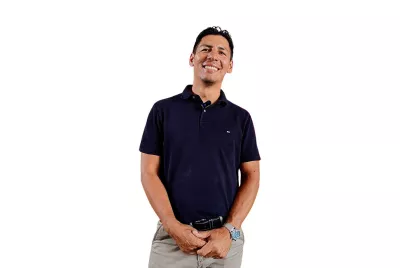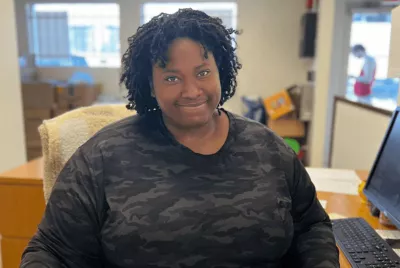Street Outreach Ride Along

“OUTREACH,” she bellowed in a remarkably loud voice for someone who otherwise seemed so reserved and soft-spoken, “Outreach, anyone home? We have a pop-up across the street with food and other things…. We also have medical.” Haley, the Covenant House Alaska outreach lead, paused and turned her head at an angle, listening at the slightly lopsided tent. After a few beats, she turned to me and said, “I don’t think they’re here.” Then she trudged through the beaten-down snow to the next “makeshift residence,” made of what once might have been a tent but had been supplemented with a tarp and what appeared to be a tattered collection of silver emergency blankets.
I struggled after her, through a clearly trodden path that, after the record snowfalls, still required quite a bit of technical expertise to cover. I arrived to hear her shout the same words, but this time, I heard someone inside respond. I didn’t quite catch what they said because their camp was just a chain-link fence and a sad row of trees away from what appeared to be snow storage for the municipality. The din of heavy moving equipment, grinding and moving heaps of snow, coupled with the highway sounds just on the other side of that, made it impossible to hear clearly. Haley seemed satisfied, however, and continued on.
On that day, as a relatively new employee, I was shadowing the Covenant House Alaska outreach team in an effort to better understand their work and its impact on the youth we serve. I had dutifully reported that morning to the program office, where I found one of the staff there combing through public court records on a computer and muttering to himself. He was looking for a youth no one had seen in a while. She had been regularly receiving services, and then she was gone, a suitcase of her things left in storage. I was glad someone was looking for her.
We found her; she was incarcerated, which, hey, wasn’t the greatest outcome, but it was certainly better than some things that could have happened to her. The staff member made a note to store her things longer-term, and then he was off to the next immediate need. I was still reeling from that task when the outreach staff arrived, handed me a loaner blue overcoat with a giant Covenant House logo, and off we went.
Covenant House has been partnering with the Anchorage Coalition to End Homelessness (ACEH) outreach program. Each day they go out, they meet the rest of the crew at the coalition offices, load up their vehicles with all manner of things to distribute at a series of pop-up events at area homeless camps or other places individuals experiencing homelessness are known to be found. I looked somewhat skeptically at the boxes of supplies stacked everywhere in what appeared to be a haphazard manner. But, both Haley and her counterpart, Mateo, produced laminated supply lists and commenced efficiently, making order out of what seemed like chaos. They carefully chose and cataloged sizes of winter clothing, hand warmers, and flashlights, and began stuffing supplies into large plastic bags and checking them off their list with a dry erase marker.
On the ride over, Mateo and Haley explained that while the pop-up was to serve anyone experiencing homelessness, the primary goal of CHA was to find and connect with the youth we serve and try to create relationships and offer help. Many youth do turn up at our door, but not all will, and this is an opportunity for us to further our reach.
On arrival, all of the agencies quickly set up their canopies and tables in the designated parking lot. As our team was preparing to head out to go door-to-door and let people know the pop-up was there, one man, who had shown up to ask for water and macaroni and cheese, recognized our blue parkas and said, “Yesterday ... maybe a couple of days ago ... there was a family of five ... with kids, back there.” Then he waved vaguely in the distance. Mateo asked him a couple of questions, trying to narrow down the location, but the man didn’t seem to have specifics. We talked about it a bit and decided the best course of action would be to save that section of the park until the end of our notifications, so, hopefully, we could find the family.
We spent the rest of the afternoon walking from dwelling to dwelling, announcing ourselves and inviting people to come for services. Mateo and Haley explained to me that we tried to treat it as the person’s or family’s “home,” and the call was a sort of “knock.” They were obviously a regular sight, as the folks walking by didn’t seem very bothered by them and either completely ignored them or nodded their heads politely. Haley and Mateo carefully combed the park, even on the less populous side, where the snow was deep and it was hard to tell if the tracks had been made by a human or moose. When it was time to go, we still hadn’t found the family of five. I hoped they had found a more permanent housing solution.
That family was weighing on me as we walked back, and as we arrived at the parking lot, Haley called out to a young man ahead of us. Haley had met him at another pop-up and knew a bit about him. She struck up a conversation. He mentioned that his housing situation was not ideal and he was looking for a job to find somewhere more permanent. Haley and Mateo got right to work giving him information, ideas, and contacts. As we pulled away, Haley and Mateo discussed the logistics of where to store their winter gear and ice cleats so they would be ready the next day. The next day, when they would be doing it all again, and continue making connections.
You might also like...
Shelter Is Only the Beginning
From crisis to care: Find out what it's like when a young person enters our doors.


